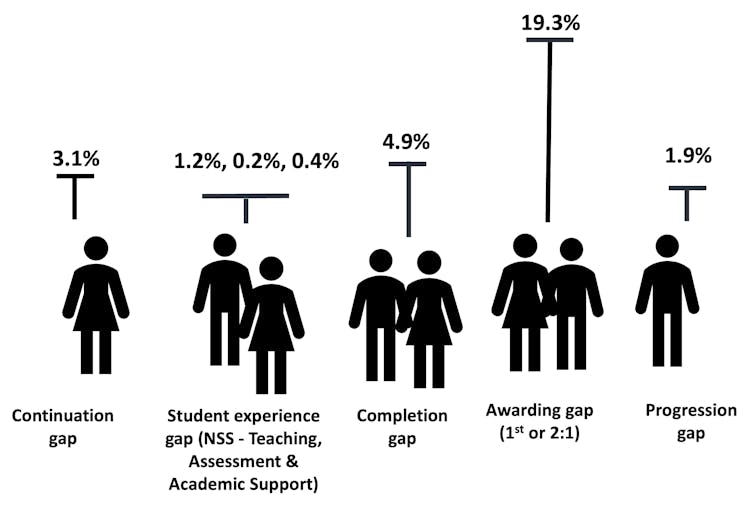
A 2020 report on racial harassment published by industry body Universities UK drew attention to the “institutional racism and systemic issues that pervade the entire higher education sector”. In the same year, the Black Lives Matter movement drew attention to inequality faced by Black people across society. UK universities pledged to do more to root out racism.
In 2022, I co-authored the sector-first Ethnic Representation Index to measure progress made by universities in England. We looked at differences in the positions of academic staff, executives and governors. We also examined gaps in student outcomes, such as degree awards, degree completion and student experience, between white students and Black, Asian and minority ethnic (BAME) students.
In 2023, we published a second, more detailed, iteration of the index. Its findings show that universities need to go further and faster in tackling inequality.
Confronting the problem
The latest iteration of the index looks at the proportion of BAME students at an institution and compares that to the proportion of BAME staff, as well as detailing the ethnicity pay gap per university. It also includes information on anti-racism initiatives as well as data on student experience and academic performance.
We know from work conducted by the National Union of Students that an academic staff with an ethnic make-up that reflects the student body is important to help foster a stronger sense of belonging for BAME students.
But the findings of this year’s report show that while BAME students make up, on average, 32.9% of undergraduates in England, the proportion of BAME students and staff declines at every stage of progression through academia from undergraduate to board level. For instance, 18.5% of academics, 14.3% of professors, and just 7.7% of executives are BAME, and that includes non-UK nationals. We call this phenomenon the “leaky pipeline” effect.
Declining proportion of BAME students and staff at job level through academia

There is also a difference in degree results for white and BAME undergraduates. BAME students are 12.3% less likely to receive a 2.1 or above. This is known as the awarding gap. At some English universities, the BAME awarding gap is over 20%.
Improving the representation of staff across all academic and executive levels will need a concerted effort to take it beyond the current ethnic profile of the population.
Focus on Black students and staff
Because the situation is worse for Black students and staff we have devised a separate Black Index alongside the BAME Index. In England, 9.5% of undergraduates are Black – but just 1.1% of professors.
The awarding gap is even greater for Black students, at 19.3%. More than a tenth of universities in England report Black awarding gaps of over 30%, while 35% of universities have a gap of over 20%.
The figure below also shows that Black students are 3.1% less likely to continue studying on their undergraduate course, and 4.9% less likely to complete their degree.
Differences in experience and outcomes between Black and white students

While disparities in representation harm BAME and Black students, they also affect staff. There is an average pay gap between white and BAME staff of 5.2%, though in some cases we found gaps as high as 20%.
Across each metric, we awarded universities a red, amber or green flag and ranked them in a league table.
Amid these disappointing findings, there are glimmers of hope. We found that 58% of the universities included in the index have a decolonisation initiative. Around 35% have an anti-racism strategy, and 78 universities have signed up to Advance HE’s Race Equality Charter (REC), which offers awards based on a university’s work to identify and address the barriers facing BAME staff and students.
Meanwhile, in Scotland, the ethnic make-up of professors and academic staff tends to reflect the BAME student population. The proportion of BAME students also tends to increase at taught postgraduate and postgraduate research level. Even so, half of Scottish universities report an awarding gap of over 10%.
Unfortunately, a university taking part in these initiatives does not necessarily translate to a better experience for their students and staff. One university rated “Silver” for its latest REC submission has a Black awarding gap of 25.4%.
It is unfortunate, too, that the index, though comprehensive, remains incomplete. Not all universities published the relevant data needed (my own university included). Freedom of Information requests were required to populate some of the index. The publishing of transparent data would reflect a commitment on the part of universities to make progress, and would help win the confidence of BAME students and staff. I urge all universities to share data in the spirit of progress, as mine will be doing next year.
While further progress may come in time, that cannot be taken for granted and will only be achieved through painstaking collective effort.
For the many thousands of BAME students and staff at British universities, and for those with aspirations to study and work there, the time that this action needs to be taken is now.
![]()
David Mba works for Birmingham City University. Acknowledgments: the latest ERI report was co-authored by Chris Lloyd-Bardsley, Adam Weigel and Sandra Longville, all at the University of Arts London (UAL)



